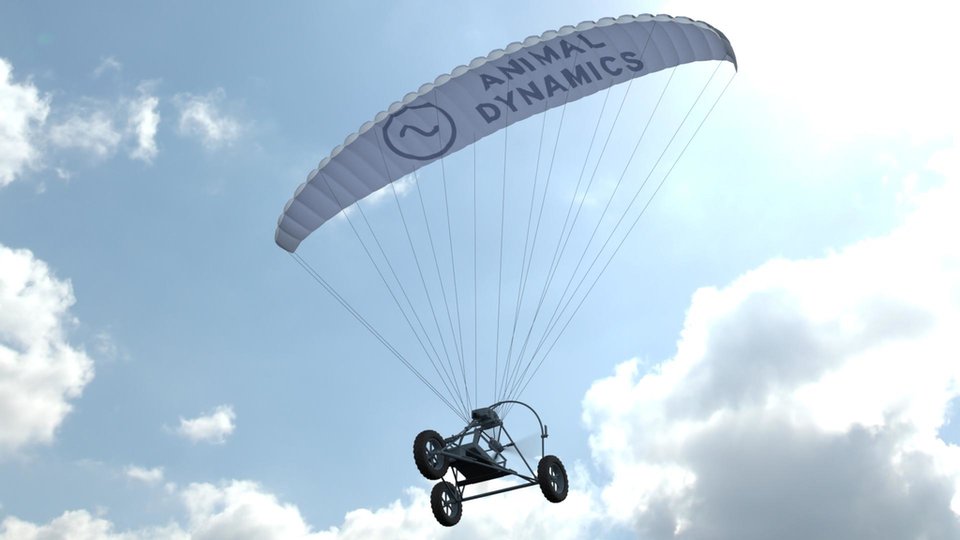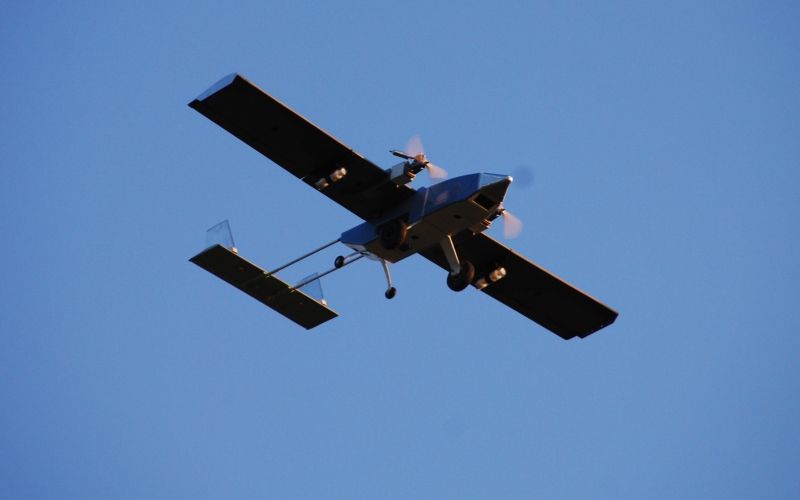land
How autonomous delivery drones could revolutionise military logistics
The UK’s Defence Science and Technology Laboratory (Dstl) is working with other government agencies to develop drones and unmanned ground robots with autonomous ‘deliver to order’ capability for frontline military logistics support. Julian Turner finds out more.
/ Image: The Stork vehicle by Animal Dynamics
Using autonomous hoverbikes, powered paragliders and self-driving ground vehicles to deliver vital supplies to front line troops may sound like something conceived by the fertile mind of a sci-fi writer, but the use of unmanned drones and robots to support military logistics in challenging environments – often dubbed ‘the last mile’ – may soon become a reality.
The Autonomous Last Mile Resupply (ALMRS) competition is a new cross-government collaboration involving the Ministry of Defence (MOD), the Department for International Development (DFID) and UK Research and Innovation (UKRI), with experts from the Defence Science and Technology Laboratory (Dstl) leading the partnership as part of the MoD’s Innovation Autonomy Challenge.
Phase 2 of ALMRS, worth £3.8m over the next 12 months, sees five winning consortiums, led by Animal Dynamics, Barnard Microsystems, Fleetonomy, Horiba Mira and QinetiQ, building prototypes of their winning designs for initial testing and evaluation this autumn.
“The ALMRS project is looking at the technologies for use in ways that could transform the delivery of logistics in not only land, but also maritime operations,” says Lieutenant Colonel Richard Craig, staff officer for robotics and autonomous systems. “It has the potential to reduce the amount of supplies stored at the frontline and increase the speed of resupply. There is the potential to increase combat mass as the technology enables the redeployment of current manpower onto different tasks.”

The Stork vehicle in flight
Taking autonomous delivery to new heights
Animal Dynamics’ project to develop autonomous powered paragliders is informed by evolutionary biomechanics. By studying how animals move, the firm aims to achieve significant improvements in the performance and efficiency of vehicles in water, air, and ground travel.
In the context of the ALMRS project, that means cutting-edge autonomous powered paragliders designed to transport medical equipment, food, fuel and vehicle parts up to 300km at speeds of up to 70km/h from a forward operating base to a pre-set GPS location on the military frontline.
The wing design of the new logistics UAV, nicknamed ‘Stork’, is based on the study of soaring birds.
Robust, stealthy in terms of low noise and radar signature, and powered by either an electric motor or an internal combustion engine, each Stork system comprises a canopy, a vehicle with landing gear, a power unit, an autonomous guidance system, comms equipment and a camera.
“The relationship with Dstl has been invaluable during the development process, because it has enabled us to experiment with technologies at this early stage,” says Animal Dynamics co-founder and CEO Alex Caccia. “The outcome is a vehicle we believe will be low-cost and robust with tremendous endurance, which in the future will have uses beyond military applications.”
“Barnard Microsystems and Cranfield University are developing a vertical take-off and landing UAV designed to handle rough terrain.”
Delivering logistical payloads to hazardous environments is also the focus of the ALMRS project entry involving Barnard Microsystems and Cranfield University, which are developing a vertical take-off and landing UAV designed to handle rough terrain.
The result is the InView UAV, a twin-engine unmanned aircraft with a dry weight of just under 20kg. Featuring a five metre wingspan and composed of lightweight composite materials, the InView is modular in design – meaning it can be transported in a small vehicle and parts can be easily replaced – and is powered by four stroke internal combustion engines that run on high-energy-density gasoline.
In terms of on-board tech, the InView uses the Inmarsat SwiftBroadband satellite data relay service, the BML autopilot system and a GPS receiver. High-quality images come courtesy of three HD cameras with video capability and the UAV also carries a thermal imager to detect people at night.

The InView UAV weighs just 20kg.
AI and Uber-style delivery drones
The QinetiQ-led ‘Metis’ team is designing an integrated logistics system that features autonomous hoverbikes and unmanned ground vehicles capable of delivering supplies to inaccessible locations.
The vehicle first scans the environment before relaying mission data back to the Metis system, which plans the best delivery route. Unmanned air and ground vehicles then autonomously navigate the route.
The use of artificial intelligence-enabled software reduces the cognitive burden of planning and managing large supply inventories and distribution routes.
“The solution will reduce the risks associated with complex humanitarian resupply operations, where aid workers can be exposed to significant dangers,” says QinetiQ. “Using advanced, autonomously navigating air and land vehicles, aid missions can be conducted at greater speed. It will also support troops on future military operations, saving lives by reducing risk and increasing the pace of operations.”
Helsinki-based Fleetonomy and its partners Thales, Thesigers, Avartek and Callen Lenz have developed an Uber-style drone delivery service that enables supply operators to command and control a fleet of UAVs during simultaneous last mile missions in urban and other environments.
Fleetonomy says the project will “demonstrate how to increase the flexibility, agility and effectiveness of frontline troops by leveraging autonomous fleets whilst simultaneously providing fused sensor data to decision-makers.”
“VIKING, using its advanced autonomy, adapts its own route on roads, tracks and across complex terrain to deliver supplies.”
Meanwhile Horiba Mira, along with Frazer Nash Consultancy, will use ALMRS Phase 2 funding of £700,000 to continue to develop its own end-to-end logistics resupply capability, using its VIKING all-terrain, multirole UGV platform.
The 6x6, two-ton robot features advanced AI-based autonomous systems, including GPS denied navigation, advanced terrain perception and object recognition and can deliver up to 600kg of supplies over 200km.
VIKING, using its advanced autonomy, adapts its own route on roads, tracks and across complex terrain to deliver supplies and will be tested and demonstrated alongside the British Army Warfighting Experiment, Autonomous Warrior Land, in the autumn of 2018.
Multiple applications: beyond military logistics
UKRI is funding the ALMRS project to the tune of £1.2m under the Robots for a Safer World Challenge as part of the Industrial Challenge Strategy Fund to support the development of technologies for extreme environments such as nuclear energy, space and deep mining.
DFID’s investment in ALMRS Phase 2 is part of a wider portfolio of projects to see how UAVs can be used to deliver life-saving aid to some of the world’s poorest people in hard-to-reach locations.
“The increasing amount of work that needs to be done in extreme environments means there are more applications for robotics and AI, such as hazardous humanitarian aid situations,” says Andrew Tyrer, challenge director of the Robots for a Safer World Challenge.
“Solving all these problems presents business opportunities for UK companies. Many of the challenges being addressed via this competition are consistent with those being addressed by the Robots for a Safer World Industrial Strategy Challenge and build on the same underlying technologies.”
A camp of Rapidly Deployable System buildings taking shape. Image: World Housing Solutions